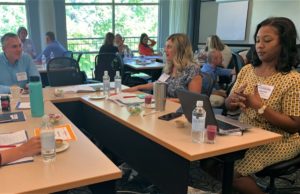By Margaret High, November 7, 2019
Public Impact® held its Opportunity Culture® Fellows Convening in September; this series highlights some of the convening topics and sessions.
Imagine opening the first all-staff email from a new principal or superintendent that clearly shows a lack of understanding or support for the Opportunity Culture® your district has in place. What do you do?
Opportunity Culture® Fellows closed the 2019 convening by brainstorming solutions to this scenario in a session on the keys to effective advocacy—one of their most-requested topics.

In surveys, Opportunity Culture® Fellows consistently highlight their desire to advocate for positive changes in education, especially for making Opportunity Culture® roles more widely available, and for sustaining them even when school or district leadership changes. Public Impact®’s Stephanie Dean, Emily Ayscue Hassel, and Sharon Kebschull Barrett created a four-page guide, Key Elements for Opportunity Culture® Advocacy, to address this—a resource for the fellows and any busy educators.
Effective advocacy means building support for an idea and getting others to act. That requires sharing information, exposing others to new information, or helping them see the known in a new way.
Fellows have advocated at the national and state level for the spread of Opportunity Culture®, but many of the common challenges they’ve seen need local advocacy, such as:
- Multi-classroom leaders (MCLs) are given oversized teams to lead;
- MCLs are assigned multiple extra duties;
- A principal new to an Opportunity Culture® school fails to understand and support Opportunity Culture®;
- Turnover of a superintendent or district-level Opportunity Culture® director leads to diminished Opportunity Culture® understanding and support.
To tackle all levels of advocacy, the Key Elements guide breaks things down into two overarching steps: define the destination and influence toward the destination.
Defining the destination is further broken down into:
- articulating the vision, goals, and proposed solution;
- providing powerful facts; and
- telling a connective story.
Influencing toward the destination focuses on:
- understanding power;
- building a coalition of support; and
- getting it done, through a plan that capitalizes on strategic moments and creates and sustains momentum.
In small groups, the fellows turned to the scenarios about a new, unsupportive principal or superintendent (also included in Key Elements for Opportunity Culture® Advocacy).
The groups considered why new leaders might not support continuing Opportunity Culture®, such as:
- not understanding the budgeting process that makes Opportunity Culture® roles and pay supplements affordable and sustainable within regular budgets;
- not understanding the difference between MCLs and traditional facilitators/coaches;
- feeling wary of leading Opportunity Culture® educators while still learning about the models;
- feeling concerned about sharing the leadership load with MCLs in this new distributed leadership model.
Educators who use their scenarios for their own discussions will come up with many solutions following the key elements. Among the ideas fellows proposed in their small groups were:
- Start with common ground—we agree that we want some form of coaching/facilitating.
- Clarify why Opportunity Culture® roles, like MCLs, are different from facilitators; highlight the Opportunity Culture® Principles.
- Highlight the ways the principal (or superintendent) benefits: student results, team teacher recruitment, retention of team teachers, great MCLs, and support from an assistant principal and MCLs.
- Turn to natural allies: parents and students. Other allies may include PTAs, active community members, and new/aspiring teachers.
- Use the data. Show pre- and post-Opportunity Culture® data—not just student growth results, but any other measures available, such as teacher retention/recruitment; discipline/suspension rates; other measures of school culture; data from student/teacher/parent surveys; teacher satisfaction data. Refer to data and research available on the Opportunity Culture® website to show effects nationally.
- Arrange visits for the principal/superintendent to successful Opportunity Culture® schools.
- Advocate with the district to ensure Opportunity Culture® is always an explicit, explained part of the hiring process; advocate for mandatory Opportunity Culture® training for principals new to the initiative.
- Build a network of Opportunity Culture® educators in the district so principals or superintendents can hear about successes. MCLs should also join the national MCL Facebook group to get support and ideas.
Have you advocated for Opportunity Culture® in your district or elsewhere? Tell us about it! Send your thoughts to Sharon Kebschull Barrett here.
Note: Public Impact® and Opportunity Culture® and Multi-Classroom Leader® are registered trademarks.
